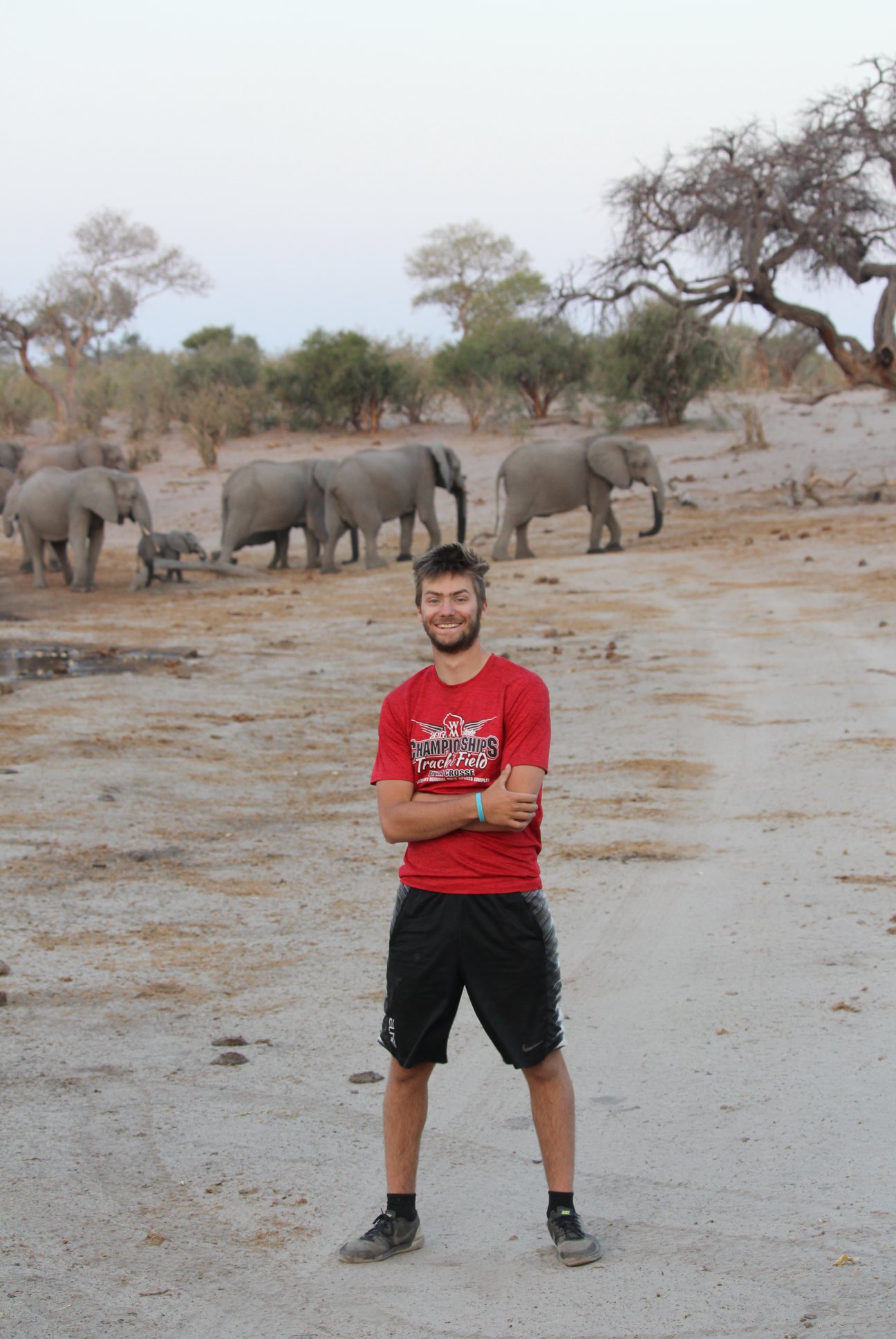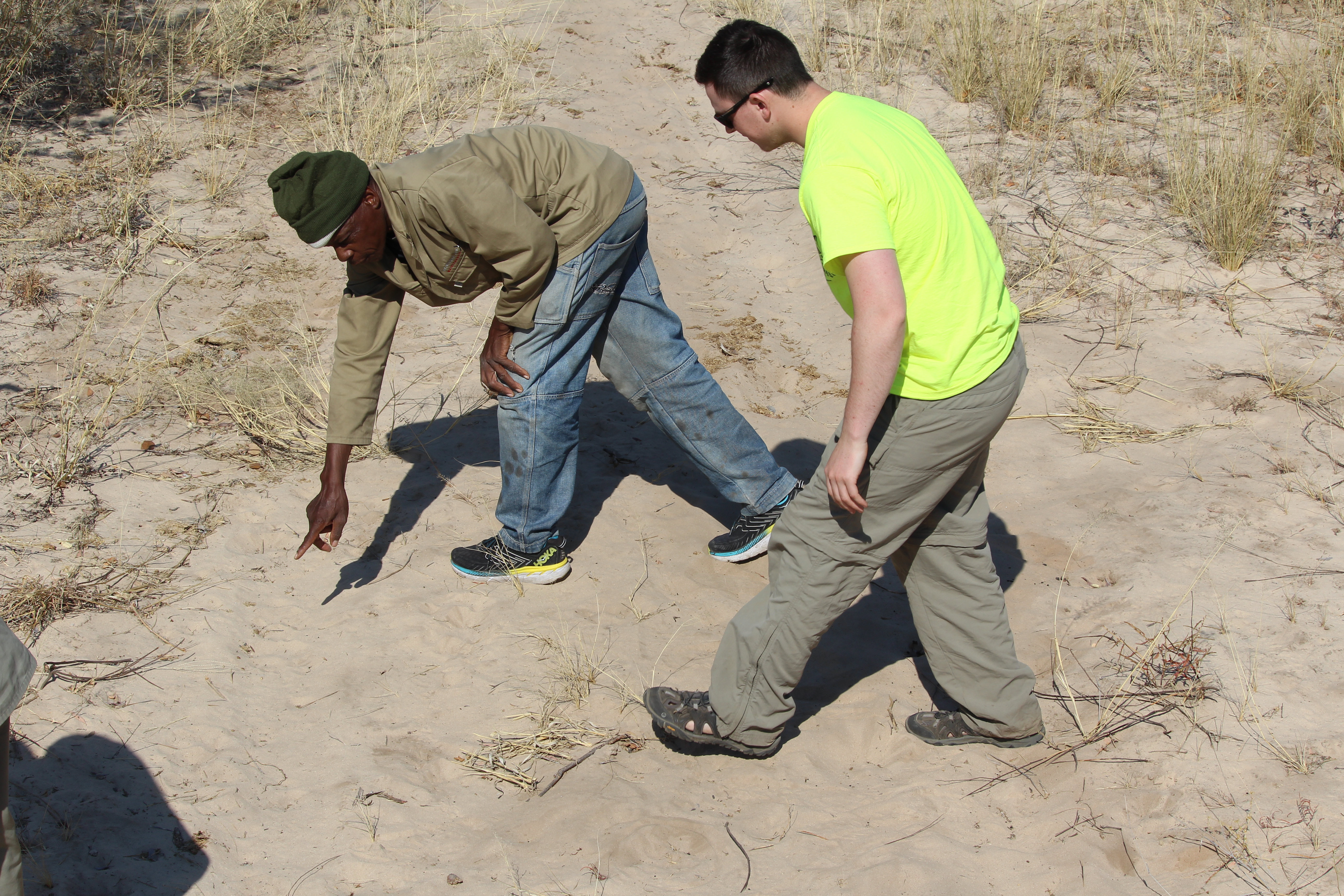by Brilyn Brecka
As sunlight spilled into the small pop-up tents, the sounds of unfamiliar bird calls and
elephants trumpeting in the distance woke the researchers, signaling the start of a new day on the
Okavango Delta. There was work to be done, so after a quick breakfast and coffee, the Land Rovers
were loaded with gear, and the group made its way even further into the bush. As they continued
to drive along the transect, an experienced, native Setswana tracker sat at the front of the vehicle
to signal when he saw the tracks of an animal. They were specifically looking for elephants, a
species not uncommon in that area of South Africa…
 The beauty of Botswana's wildlife can shock many, including two undergraduate students from UW - Stevens Point: Nate Weisenbeck and Tommy Young. When offered the
opportunity to go on the journey of a lifetime in 2019, the two wildlife
ecology students were excited for the new adventure, and the
experience they received was well worth the 16-hour flight to
southern Africa.
The beauty of Botswana's wildlife can shock many, including two undergraduate students from UW - Stevens Point: Nate Weisenbeck and Tommy Young. When offered the
opportunity to go on the journey of a lifetime in 2019, the two wildlife
ecology students were excited for the new adventure, and the
experience they received was well worth the 16-hour flight to
southern Africa.
Tommy’s adventure started in the classroom at UWSP,
8,500 miles away from Botswana. When a former South
Africa Internship student presented about his experience at a
Student Chapter of The Wildlife Society meeting, Tommy was
intrigued. He reached out to Scott Hygnstrom, Director of the
UWSP-CNR-Wisconsin Center for Wildlife and applied for
the internship. The South Africa Internship program is
designed to complement UWSP-CNR’s Summer Field
Experience at Treehaven near Tomahawk, Wisconsin. One
half of the summer is spent at Treehaven and the other half is spent as a student intern in Southern
Africa. Interns gain a wide array of field skills and a greater understanding of human-wildlife
conflicts in the southern region of Africa, and many of these skills and lessons translate to similar
studies and issues in the US.
 A typical day living in the bush was
extremely different from home in the Midwest.
Nate described the bush as differing from
Wisconsin in “every way possible.” From the
cloudless skies to the lack of running water, he
compared the experience to camping with pop-up tents and fire-cooked meals. After spending
time with locals, Nate was shocked by the
simplicity of life there: “they know that life is
day to day… and when you do simplify life, it
gets so much easier and you are happier.” After
buying supplies and groceries from the market,
they would go “fly camping” to conduct their research; they would travel until the sun
set and camp wherever they ended up for
the night. From sun-up to sun-down, the
group would work to collect data for their
research projects.
A typical day living in the bush was
extremely different from home in the Midwest.
Nate described the bush as differing from
Wisconsin in “every way possible.” From the
cloudless skies to the lack of running water, he
compared the experience to camping with pop-up tents and fire-cooked meals. After spending
time with locals, Nate was shocked by the
simplicity of life there: “they know that life is
day to day… and when you do simplify life, it
gets so much easier and you are happier.” After
buying supplies and groceries from the market,
they would go “fly camping” to conduct their research; they would travel until the sun
set and camp wherever they ended up for
the night. From sun-up to sun-down, the
group would work to collect data for their
research projects.
Tommy and Nate’s own summer
project focused on evaluating the
population dynamics of elephants in
Botswana. Botswana is home to one of
the only overabundant populations of
elephants in the world, and the
population has continued growing in
recent years. The growth in the elephant
population can create a wide variety of
human-wildlife conflicts in Botswana
and can have negative impacts on the land and economy. Residents are greatly concerned about
destruction of habitat and crops caused by these massive creatures. Historically, hunting elephants
was legal, provided jobs and food for locals, and was a way to manage elephant populations
effectively. In recent years, elephant populations have increased due to hunting bans; the effects
of which resulted in a strain on the habitat’s ability to support them. This increase in population
has caused issues for both the land and the people who call Botswana home.
 During transect surveys, Tommy and Nate used a technique called “photogrammetry” to
determine the age of any elephant they saw. Photogrammetry is the science of making
measurements from photographs. Tommy and Nate worked in tandem; one student took a photo
of the elephant and the other determined the elephant’s exact distance from the camera with a
range finder. With these data, they could determine the elephant’s height from foot to shoulder.
This information was crucial because age can be directly interpreted from height measurements.
The sex of the elephant also was recorded to get accurate estimates of population parameters.
During transect surveys, Tommy and Nate used a technique called “photogrammetry” to
determine the age of any elephant they saw. Photogrammetry is the science of making
measurements from photographs. Tommy and Nate worked in tandem; one student took a photo
of the elephant and the other determined the elephant’s exact distance from the camera with a
range finder. With these data, they could determine the elephant’s height from foot to shoulder.
This information was crucial because age can be directly interpreted from height measurements.
The sex of the elephant also was recorded to get accurate estimates of population parameters.
Tommy and Nate discovered there
were almost twice as many adult female
elephants than adult males. In addition,
juveniles (1-11 years) accounted for a
large percentage of Botswana’s elephant
population. These observations can
provide important insights into how
elephant populations can be managed in
the future. Tommy believes, “more
research needs to be done on the negative
impacts that the elephants are having
because we know what they can do, but
there’s nobody out there who has looked
at the environment of Botswana and
proven the negative effects on the land.”
The South Africa Internship program is made possible through the Douglas R. Stephens
Endowment and a donation by Annette Braithwait, who provided funding for wildlife research,
student engagement, professional travel, and faculty-mentored projects. Also integral to the
success of this internship is a partnership with Christiaan Winterbaach and Tau Consultants, a
private wildlife research organization located in Botswana.
Photo credits: ©Nate Weisenbeck ©Tommy Young
